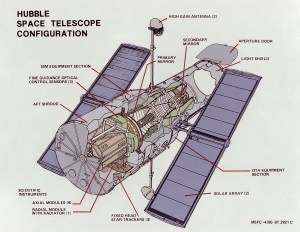
Hubble Space Telescope Configuration (REF # MSFC-4/85-ST-2821C)
This image illustrates the overall Hubble Space Telescope (HST) configuration. Hubble is the product of a partnership between NASA, the European Space Agency, contractors, and the international community of astronomers. It is named after Edwin P. Hubble, an American astronomer who discovered the expanding nature of the universe and was the first to realize the true nature of galaxies. The purpose of Hubble, the most complex and sensitive optical telescope ever made, is to study the cosmos from a low Earth orbit. By placing the telescope in space, astronomers are able to collect data that is free of Earth's atmosphere. Hubble detects objects 25 times fainter than the dimmest objects seen from Earth and provides astronomers with an observable universe 250 times larger than is visible from ground-based telescopes, extending our view more than 13 billion light-years away. Hubble views galaxies, stars, planets, comets, planet formation in other solar systems, and even unusual phenomena such as quasars, with 10 times the clarity of ground-based telescopes. The major elements of Hubble are the Optical Telescope Assembly (OTA), the Support System Module (SSM), and the Scientific Instruments (SI). Hubble is approximately the size of a railroad car, with two cylinders joined together and wrapped in a silvery reflective heat shield blanket. Wing-like solar arrays extend horizontally from each side of these cylinders, and dish-shaped anternas extend above and below the body of the telescope. Hubble was deployed from the Space Shuttle Discovery (STS-31 mission) into Earth orbit in April 1990. The Marshall Space Flight Center was responsible for the design, development, and construction of the observatory. The Perkin-Elmer Corporation in Danbury, Connecticut, developed the optical system and guidance sensors. The Lockheed Missile and Space Company of Sunnyvale, California, produced the protective outer shroud and spacecraft systems, and assembled and tested the finished telescope.
- X





























